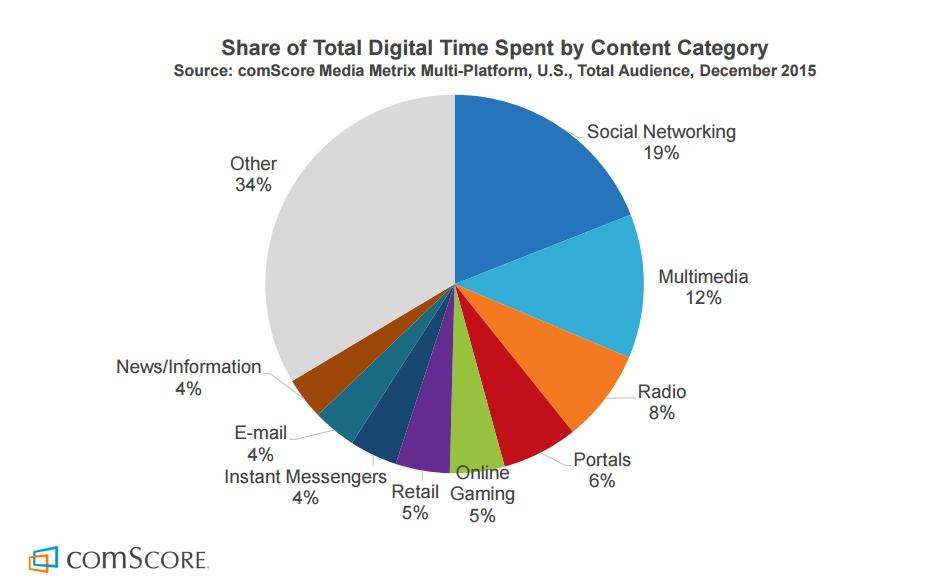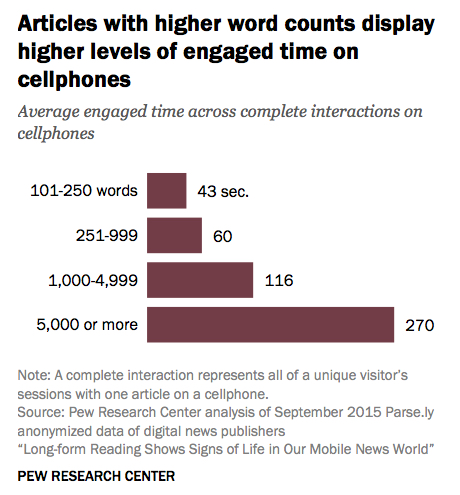Long-form storytelling on mobile, consumers willing to pay for ad-free browsing, the continuing growth of social media, brand awareness on social platforms, the IAB’s latest digital ad spend report, and more are covered in this installment of TFP’s Media Metrics roundup.
To help you keep up with trends and prepare for changes just around the corner, each month we compile excerpts from some key reports covering issues affecting the publishing and media industries. Here are our top picks.
People Will Read Your Long Stories on Their Phones (for Two Minutes, Anyway) (Nieman Lab)
- According to a new Pew report, smartphone users spend 123 seconds with long-form stories, about twice as much time as they spend with short articles (57 seconds). It also found that readers showed interest in long stories at about the same rate they did with shorter ones.
- While Facebook generates significantly more traffic than Twitter, users spend 133 seconds reading articles from Twitter versus 107 seconds for articles from Facebook. The report said LinkedIn, Google Plus, StumbleUpon, Reddit, Tumblr, and Pinterest combined drive only 2% of total social referrals.
- The study also found that no matter what the length of the story, readers typically find articles on the day they’re published, and the longest periods of engagement occur in late-night hours and in the morning.
Study: People Would Pay to Avoid Web Ads (Media Life Magazine)
- Accenture found 42% of 28,000 survey respondents would pay for an ad-free browsing experience.
- Of all respondents, 61% are familiar with ad blocking. Some 69% of users 18 to 24 years old know about ad blockers, while 66% of those 25 to 34 years old are aware of the technology.
- The survey also found that awareness of ad blocking options is highest in Mexico (82%) and in Latin American countries in general (78%). While 47% of users in emerging markets said they are planning to use ad blockers, only 34% of users in mature markets said the same.
New ComScore Traffic Report Underlines the  Strength of Facebook, Rise of Snapchat (Social Media Today)
Strength of Facebook, Rise of Snapchat (Social Media Today)
- Social networking now accounts for one in every five minutes spent on the Internet.
- Monthly visits to the top 1,000 websites increased to an average of 16.8 million per month in 2015, with mobile surpassing desktop.
- Mobile apps account for 61% of all social media time spent among U.S. users.
- Three in every five Internet users age 18 to 24 years old now actively use Snapchat.
43 Percent of Social Media Users Don’t Know Where the Stories They Read Originally Appeared (Digiday)
- Research from trade association Digital Content Next found 43% of people reading stories on social media aren’t aware of which publisher provided the original content. Conversely, 52% said they seek out known and trusted brands, meaning those publishers that are “well established have an advantage on social media,” the report said.
- It added, however, that 40% of study participants said they would click on an article of interest from a site they were unfamiliar with, which “suggests social media can play a role in getting people to discover publishers.”
- In terms of category, brand awareness was highest among providers of national news and sports stories (61%).
- Brand awareness was lowest (52%) in the lifestyle category, which is often associated with evergreen content. The report noted, though, that recognition can vary widely across a range of publishers.
U.S. Internet Ad Spending Accelerated in 2015 to Reach $59.6 Billion (The Wall Street Journal)
- According to the Interactive Advertising Bureau’s annual digital ad spend report, U.S. online ad revenues reached $59.6 billion in 2015, a 20% increase over the previous year.
- Mobile ad spend jumped 66% year over year, to $20.7 billion. Mobile accounted for 35% of total digital ad spending in 2015, up from 25% in 2014.
- The report said non-mobile social media advertising increased 55% to $10.9 billion, while non-mobile digital video advertising saw a 30% increase, reaching $4.2 billion.
Here’s How Much Advertisers Have Increased Their Digital Video Ad Spending (Adweek)
- The IAB digital advertising report found that 72% of media buyers will shift advertising budgets away from television toward digital video.
- Of those increasing their digital video advertising, 41% are cutting their cable TV advertising to do so and 47% are decreasing broadcast TV spending.
- Some 68% of survey respondents said they believe original digital video “will become as important as original TV programming in the next three to five years.”
- Overall, media buyers have increased their investments in original digital video programming by 114% in the past two years, the report said.
Report: Shorter Isn’t Better, Photos Aren’t Always Alluring and Deep Digging Pays Off (Poynter)
- An American Press Institute study confirmed that longer stories do well among smartphone users: Articles longer than 1,200 words got 23% more engagement, 45% more social referrals, and 11% more pageviews.
- Photos and audio or video clips increased engagement overall by 19%, but results depended on the type of article.
- Enterprise stories see 48% more engagement than other types of content, but they make up only 1% of content produced. Producing little more than a basic news story (or “light enterprise”) didn’t increase engagement at all.
Report: Subscription Discounts Drive Down Newsstand Sales (Folio Magazine)
- Not surprisingly, a study by MagNet showed newsstand sales can drop substantially when magazines offer aggressive subscription discounts, with titles offering more than 70% off per-issue subscription rates seeing declines of more than 16%.
- Titles offering discounts of 50% to 70% saw an 11% drop in sales on average, while discounts below 50% off resulted in declines of between 3% and 5%.
- The report said the average subscription discount was 63% off the cover price for monthly magazines compared with 27% for quarterly titles. In line with overall findings, monthly magazines with the higher subscription discount saw newsstand sales decline 15.2% over the two-year study, while sales of quarterly titles dropped just 3.4%.
Millennials, Gen-Z Alienated by Ads in Social News Feeds (Study) (Social Times)
- A recent study by Harris Poll found millennial and Gen-Z readers don’t like being targeted by ads on their social news feeds, with 74% of the two demographic groups combined saying they object to such advertising.
- Some 56% said they dislike ads in their news feeds enough to reduce or eliminate their use of social media.
- The study also showed that behind celebrity endorsements, millennials and Gen Xers distrust social networks for product information and reviews the most. In contrast, they trust online product review sites most (85%), followed by company websites (66%), communities (65%), and people they follow (57%).
Poll: Only 6% of Americans Say They Really Trust Media (NetNewsCheck)
- Distrust in news media is growing, with just 6% of those surveyed in the Media Insight Study saying they have confidence in the media, about equal to their trust in Congress and significantly below that for other public institutions.
- The study found that almost 90% of Americans believe “it’s extremely or very important that the media get their facts correct.”
- Most people get news from social media, most often from Facebook, the report said. But only 12% of users said they have trust in the news and information they find on the site.
Think Papers’ Websites Are Gaining? Think Again. (Media Life Magazine)
- Suggesting newspapers need to rethink their digital strategies, recent research shows the average reach of a newspaper website within the paper’s market has changed little from 2007 to 2015, going from 9.8% to just 10%.
- In fact, more than half of newspaper websites actually saw declines from 2011 to 2015, according to the study.
- While print readership declined from 42.4% in 2007 to 28.8% in 2015, it’s more than double online readership among consumers 18 to 24 years old (19.9% vs. 7.8%) and tops online in every other age group.
Media Metrics is a monthly feature from Technology for Publishing, aimed at keeping you armed with the latest industry data. If you’d like to share something you’ve read, drop us a note. And keep up with the latest industry news coverage by signing up for our This Week in Publishing emails or our Publishing Innovations newsletter.
Posted by: Margot Knorr Mancini



